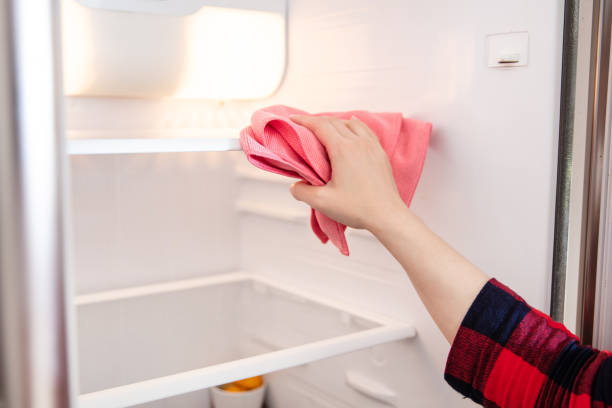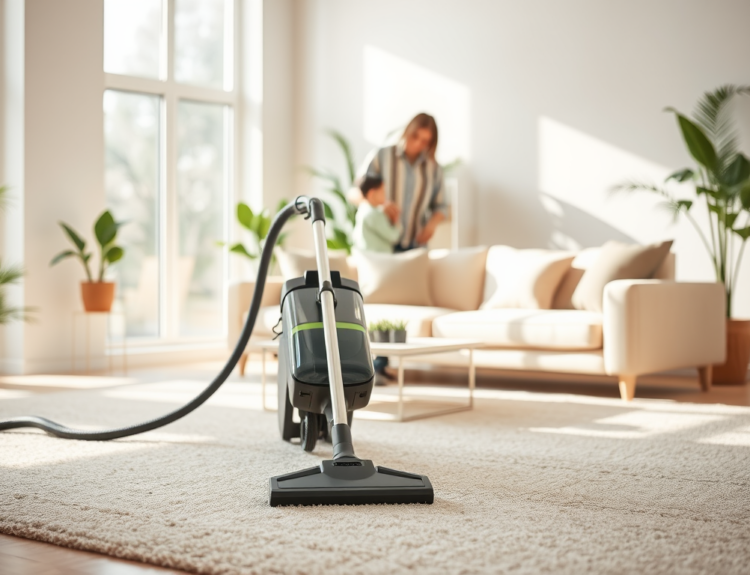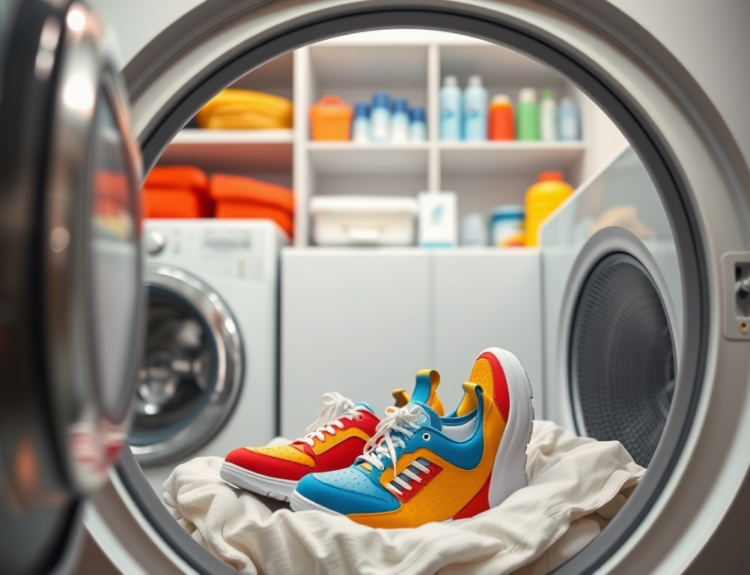Baking soda’s cleaning prowess lies in its slight abrasiveness and natural deodorizing properties, which make it an ideal choice for a deeper clean that will not harm your fridge’s interior surfaces. It can neutralize acidic compounds and absorb unwelcome smells, ensuring that when you slide your food back onto the shelves, it rests in a sanitized environment. Additionally, bicarbonate of soda is safe and eco-friendly, so you can clean without worrying about toxic residues that might be harmful to you and your family.
Another reason why baking soda is so popular is that it could also be used to clean other parts of your home. Its versatility extends from the kitchen to the bathroom, and since it does not produce strong fumes or leave behind dangerous chemicals, it’s a staple in many households’ green cleaning arsenals.

Preparing to Clean Your Fridge
Cleaning your fridge might not be on your list of fun activities, but it’s a necessary chore. A good time to clean is right before you do your grocery shopping when your fridge is at its emptiest. This will help you identify items that might have expired and need tossing out.
When you are ready to begin, gather these essential items:
- Bicarbonate of soda
- Hot water
- Dry cloths or sponges
- A small bucket or bowl
- Protective gloves, if desired
- A cooler or a second fridge, if available, to store your perishables
The ratio for your homemade cleaning solution is straightforward: mix one part of baking soda with two parts of water. For tougher stains or for parts of the fridge that might need extra attention, creating a paste with a thicker consistency by using more baking soda will also do the trick.
Step-by-Step Instructions to Clean Your Fridge
- Emptying and Detaching Components Start by turning off your fridge to save energy and prevent any electrical mishaps. Then, remove all the food, shelves, drawers, and any removable parts. Place your food in a cooler or a secondary fridge to keep it fresh. This is also a good time to throw away any expired products or items you no longer want.
- Creating your Bicarbonate of Soda Cleaning Solution In a small bucket or bowl, mix approximately one part bicarbonate of soda with two parts warm water to create your natural cleaning solution. If certain areas require more attention, use a mix with a higher concentration of baking soda for a paste-like texture. For those particularly stubborn stains, a solution of one part baking soda to one part vinegar will help break them down. Mixture Ingredients Use Case Standard Cleaning Fluid 1 part baking soda, 2 parts water General fridge cleaning Paste for Tough Stains Higher concentration of baking soda with water Stubborn stains, dried spills Stain Remover Equal parts baking soda and vinegar Set-in stains and odors
- The Cleaning Process Use a sponge or cloth dipped in the baking soda solution to wipe down the interior surfaces of the fridge, including the walls, base, and ceiling. Pay special attention to corners and crevices where crumbs and liquids might have hidden. For an even deeper clean, apply the paste to any stubborn spots and let it sit for several minutes before scrubbing it off. Ensure you’re also cleaning the removed components, such as shelves and bins, with the same solution. This will help maintain consistency in cleanliness and odor removal throughout the fridge. After you have scrubbed all areas of the fridge with the baking soda solution, it’s time to rinse. Using a clean cloth dipped in plain water, then rinse off the baking soda mixture from all surfaces. This step is crucial to avoid any residue being left behind that could also influence the taste of your stored food.
Wiping Dry
Post-rinsing, it is important to dry all surfaces and components thoroughly. Moist spots could lead to bacterial growth, so take your time drying with clean, dry cloths. This step helps keep your fridge free from mildew and ensures that no moisture is trapped when you put the food back in.
Wiping dry also means drying the removable parts separately before putting them back into place. The rubber seal on the door, often neglected, should be carefully dried and examined for any debris that might have collected – this area is a hot spot for grime and should not be overlooked.

Aftercare and Maintenance Tips
Maintaining the cleanliness of your fridge doesn’t end with wiping dry—it’s an ongoing commitment. To help make future cleanings easier and less frequent, there are several aftercare steps you can take:
- Store food in airtight containers to minimize spills and odors.
- Keep an open box of baking soda inside to continuously absorb odors.
- Wipe up any spills immediately to prevent them from hardening and becoming more difficult to clean later on.
- Double-check the temperature settings of your fridge, as proper temperatures can slow down bacterial growth and help keep food fresh longer.
Implementing preventative measures will also go a long way in keeping your fridge clean. For instance, placing a liner at the bottom of your crisper drawers will collect any debris and can be removed and cleaned separately. This is an efficient way to maintain cleanliness without needing to empty the entire fridge again. Additionally, scheduling regular cleaning sessions, perhaps once a season, will ensure your fridge never reverts back to a state requiring another deep clean.
By integrating these maintenance tips, not only will your fridge stay hygienic, but the food stored within it will also remain fresher for longer. This approach to refrigerator cleanliness helps keep your kitchen a health-friendly environment and could also save you time and effort in the long run.

Conclusion
In conclusion, cleaning your fridge with bicarbonate of soda is a simple, safe, and highly effective method to ensure it remains a clean and pleasant environment for your food. By following the steps outlined in this guide—from gathering the necessary items to emptying the fridge, making a cleaning solution, and wiping it down to aftercare and maintenance—you can achieve a deeper clean that also supports healthy food storage practices. Regular use of baking soda for cleaning will also promote an odor-free, sparkling interior that makes your kitchen chores a bit more enjoyable. Remember, a clean fridge not only means a healthier home but also contributes to less food waste and improved efficiency of your appliance.
FAQs
Q1: How often should I clean my fridge with bicarbonate of soda?
A1: It’s a good practice to give your fridge a thorough clean with bicarbonate of soda roughly every three to four months. However, if you notice odors or spills, it’s wise to clean those areas immediately to avoid harder-to-clean messes and persistent smells.
Q2: Can I use bicarbonate of soda to clean the freezer as well?
A2: Absolutely, you can use a similar method to clean your freezer with bicarbonate of soda. Make sure you defrost the freezer first, and then apply the same cleaning solution but ensure you dry the surfaces thoroughly to prevent ice from forming on any remaining moisture.
Q3: What other areas of the kitchen can benefit from cleaning with bicarbonate of soda?
A3: Bicarbonate of soda is extremely versatile and can be used to clean sinks, tiled surfaces, and even stubborn grease from oven interiors or stovetops. It’s a natural cleaner that is also effective in removing tea and coffee stains from mugs.
Q4: Will cleaning my fridge with bicarbonate of soda affect the taste of my food?
A4: If you rinse and dry all surfaces properly after cleaning, there should be no residual taste of bicarbonate of soda on your food. It’s non-toxic and food-safe when used as a cleaner, provided it’s washed off thoroughly.
Q5: What if I have particularly tough stains, can I leave the baking soda paste on overnight in my fridge?
A5: For very stubborn stains, you can leave a thicker paste of baking soda and water on the affected area for a longer period, even overnight. Just make sure to rinse it well afterwards, and you might find it significantly easier to wipe the stain away.



